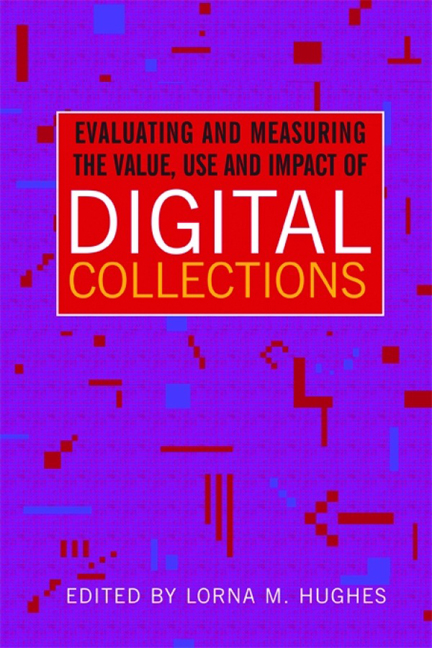Book contents
- Frontmatter
- Contents
- Figures and tables
- Foreword
- Acknowledgements
- The contributors
- 1 Introduction: the value, use and impact of digital collections
- Part 1 Digital transformations in libraries, museums and archives
- Part 2 Understanding and measuring the use, impact and value of digital collections
- 5 A strategic approach to the understanding and evaluation of impact
- 6 User needs in digitization
- 7 Measuring impact and use: scholarly information-seeking behaviour
- 8 The value and impact of digitized resources for learning, teaching, research and enjoyment
- Part 3 Enhancing the future impact and value of digital collections
- References and further reading
- Index
- Miscellaneous Endmatter
- Miscellaneous Endmatter
8 - The value and impact of digitized resources for learning, teaching, research and enjoyment
from Part 2 - Understanding and measuring the use, impact and value of digital collections
Published online by Cambridge University Press: 08 June 2018
- Frontmatter
- Contents
- Figures and tables
- Foreword
- Acknowledgements
- The contributors
- 1 Introduction: the value, use and impact of digital collections
- Part 1 Digital transformations in libraries, museums and archives
- Part 2 Understanding and measuring the use, impact and value of digital collections
- 5 A strategic approach to the understanding and evaluation of impact
- 6 User needs in digitization
- 7 Measuring impact and use: scholarly information-seeking behaviour
- 8 The value and impact of digitized resources for learning, teaching, research and enjoyment
- Part 3 Enhancing the future impact and value of digital collections
- References and further reading
- Index
- Miscellaneous Endmatter
- Miscellaneous Endmatter
Summary
Introduction
Imagine walking into one of Britain's great cathedrals. As you take in the architectural, cultural and religious ambience, your mobile device automatically engages with content on your behalf.
So, just when you ask for it, the local tour is available in your own language. But there is much more: images and information on the stained glass too high to view, videos of famous ceremonies, 3D walk-throughs showing how the cathedral may have looked in previous centuries, full text of historic and literary references, a list of people buried, baptized or married, choral works performed, oral histories of local residents, news reports through the centuries; this list of opportunities could and will grow even longer.
This is the inherent promise of digitized resources and yet we have not achieved this goal with many of our digital collections. Technology exists to drive forward a vision of intelligent environments that supply the right information to the right person at the right time. Paradoxically, what is missing is the depth of digitized content to make such technical developments more significant than mere mobile playthings. The treasure house of content has to be digitized much more comprehensively.
Much has been achieved, but there are opportunities for much more impact, benefit and a greater return on the investment made in creating digital collections if we continue to invest in the knowledge economy by digitizing our wealth of information resources.
This chapter will consider the opportunities and impacts that digitized resources have made for learning, teaching, research and society. The focus for this chapter comes from the significant impact and value in the UK discovered during the JISC-funded research project, Inspiring Research, Inspiring Scholarship (Tanner and Deegan, 2011). It will conclude with the suggestion that the impacts of digitized resources are being negated by the very modes of measurement and evaluation currently in place, and will posit fresh areas for investigation.
Overview of opportunities, benefits and impacts from digitized Resources
What the Bodleian Library is doing now, in digitising large portions of our vast collections, is like the human genome project. Thousands of people can evaluate and use creatively the digital resources to discover new ideas and make innovations.
- Type
- Chapter
- Information
- Publisher: FacetPrint publication year: 2011
- 2
- Cited by



